This weekend’s presidential election in Argentina will have lasting implications for grain markets, says an analyst.
Both candidates say they will eliminate production-limiting export taxes on soybeans, corn and wheat.
“The real bearish situation for me is that this adds to the oversupply situation in the long run,” said Pedro Dejneka, president of AGR Brasil, an affiliate of AgResource Company.
Frontrunner Mauricio Macri, leader of the right of centre Republican Proposal party, will introduce a “market friendly” approach to agriculture.
Macri’s farm adviser said Argentina’s grain and oilseed production would increase 30 percent, or 30 million tonnes, over the next four years under a Macri government.
Read Also

Moe shares goals for Chinese trade mission
To advocate on behalf of Saskatchewan agriculture and other industries, as well as the Canadian canola, pork, pulse, and seafood industries, Saskatchewan Premier, Scott Moe, is travelling to China on a trade mission.
Dejneka believes it because the Argentine farmer is eagerly awaiting the prospect of selling grain without punitive export quotas and taxes.
“He’s coming out to party,” he said. “Let’s plant, baby.”
Macri said he would immediately cut the soybean export tax to 30 percent from 35 percent and reduce it by a further five percentage points every year until it is eliminated.
He has also committed to eliminate corn and wheat export quotas and export taxes of 20 to 23 percent upon taking office Dec. 10.
Outgoing president Cristina Fernandez de Kirchner was unpopular with farmers because of her government’s left of centre interventionist policies.
She is not allowed to run for a third term. Daniel Scioli, her successor as leader of the Justicialist Party, is in a tighter election race than many predicted.
Scioli captured 37 percent of the votes after the first round of voting Oct. 25, compared to 34 percent for Macri.
Third place candidate Sergio Massa dropped out of the race, and Dejneka believes he will back Macri with his 21 percent of the votes when the second round of the election occurs Nov. 22.
That has Scioli scrambling to lure more votes from Argentina’s middle and upper classes, many of whom are farmers.
“He now feels the pressure. He really, really feels the pressure,” said Dejneka.
Scioli announced a big departure from the policies of his predecessor last week. He promised to cut the soybean levy to 25 percent on his first day in office and eliminate corn and wheat export taxes.
Dejneka said the soybean market can’t sustain a rally because the market is worried about a torrent of stockpiled Argentine soybeans being exported following the election.
Analysts estimate farmers are sitting on eight to 18 million tonnes of soybeans as they wait for a drop in export taxes. Macri’s farm adviser said $12.9 billion worth of crops are stored on the country’s farms.
Dejneka said the market also expects Macri to sharply devalue the peso, which would be another windfall for farmers.
However, he believes that will not happen because the country is already wrestling with a real inflation rate near 30 percent per year. Devaluing the currency would boost inflation.
“Do you really want to do that if you just took over?” said Dejneka.
“You’re trying to appease the masses, who by the way don’t like you because you’re a right of centre candidate and they expect you to already cut a lot of the social assistance programs and now you’re going to come in and bump up inflation?”
Dejneka believes the market is overly bearish. He thinks maybe one or two million tonnes of stockpiled soybeans will initially hit the market, rather than 12 or 13 million tonnes.
He expects the impact will be felt more in 2016-17 than 2015-16 when a steady stream of South American soybeans will depress prices as a huge anticipated new crop is added to existing stocks.
“It’s a sustainable punch in the face to U.S. exports,” said Dejneka.
“I think soybeans by March next year could easily navigate towards $8 (per bushel).”
He is advising growers to sell into any rally that takes prices close to $9 over the next few months.
Argentina’s election is also bad news for corn and wheat markets. Most of the additional 30 million tonnes of production will come from those two crops because of the immediate elimination of export taxes and quotas.
That would further strengthen Argentina’s position as the world’s third largest corn exporter and eighth largest wheat exporter.
Growing more corn and wheat won’t necessarily weaken the country’s third place rank as a soybean exporter because it would break the practice of growing soybeans on soybeans.
“They can potentially increase their yields in all three crops because now they will have a healthy crop rotation that they haven’t had before,” said Dejneka.
He believes it will be difficult to break out of the cycle of low grain and oilseed prices because there is no demand shock in sight.
The supply side will have to do the heavy lifting, but a big crop of South American corn and soybeans is on the way, a huge stockpile of Argentinean soybeans will eventually come to market and there is the potential for even bigger future crops in Brazil and Argentina.
“It might be a long, painful road back to recovering prices,” said Dejneka.















